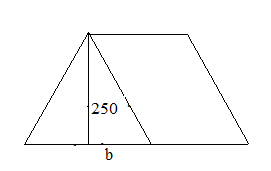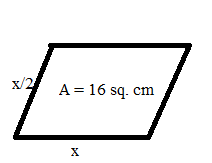The term ‘base’ refers to the length of one side and height to the length of a perpendicular segment between that side and the opposite side. The base of the triangle refers to the bottom line of a triangle is the base and it can be one of the three sides of the triangle. Before that, you have to know the relation between the area of the triangle and the parallelogram from here. Let us discuss in detail the relationship between the base and height in a Triangle and a Parallelogram in this article.
Base and Height (Altitude) in a Triangle and a Parallelogram
The altitude of the triangle is n times the altitude of the parallelogram. Let the length of the base of a triangle and a parallelogram be ‘b’.
Relationship between Area of Triangle and Parallelogram:
Area of parallelogram = base × height
Area of triangle = 1/2 × base × height
Calculation:
Length of the base of a triangle and parallelogram be ‘b’.
Base of triangle = base of parallelogram = b
Let a is the altitude of the parallelogram
The altitude of the triangle = Ka
It is given that area of parallelogram = area of the triangle
ab = 1/2 × ka × b
k = 2
Thus the value of k is 2.
Also, Check:
Problems Related to Base and Altitude in a Triangle and a Parallelogram
Example 1.
A triangle and parallelogram are constructed on the same base such that their area is equal. If the altitude of the parallelogram is 100m, then find the altitude of the triangle.
Solution:
Given that
A triangle and a parallelogram are constructed on the same base, and also their area is equal.
We have to find the height of the triangle.
Let us assume the base of the triangle and parallelogram as b as they are constructed on the same base
Let the altitude of the triangle be h1 and of the parallelogram is h2
Area of triangle = ½ × b × h1
Area of parallelogram = b × h2
Both the areas are equal.
Therefore, ½ × b × h1 = b × h2
We know that
h2 = 100
½ × b × h1 = b × 100
½ × h1 = 100
h1 = 100 × 2
h1 = 200
Hence, the altitude of the given triangle is 200 m.
Example 2.
A triangle and parallelogram are constructed on the same base such that their area is equal. If the altitude of the parallelogram is 250m, then find the altitude of the triangle.
Solution:
Given that
A triangle and a parallelogram are constructed on the same base, and also their area is equal.
We have to find the height of the triangle.
Let us assume the base of the triangle and parallelogram as b as they are constructed on the same base
Let the altitude of the triangle is h1 and of the parallelogram is h2

Area of triangle = ½ × b × h1
Area of parallelogram = b × h2
Both the areas are equal.
Therefore, ½ × b × h1 = b × h2
We know that
h2 = 250
½ × b × h1 = b × 250
½ × h1 = 250
h1 = 250 × 2
h1 = 500
Hence, the altitude of the given triangle is 500 m.
Example 3.
The area of a parallelogram with a base 24 cm is equal to the area of a triangle of sides 10 cm, 24 cm and 26 cm. Find the altitude of the parallelogram.
Solution:
The height of the parallelogram = h.
Area of a parallelogram =base×height =24h=24h

Semi-Perimeter of triangle with sides 10cm, 24cm and 26cm is
s = (a+b+c)/2
s = (10+24+26)/2
s = 60/2
s = 30
We know that
Area of triangle = √s(s – a)(s – b)(s – c)
=√30(30−10)(30−24)(30−26)
=√30×20×6×4
=120 square cm
Given that
The area of the parallelogram is equal to the area to triangle,
24h=120
h=5 cm
Therefore, The height of the parallelogram is equal to 5 cm.
Example 4.
The area of a parallelogram with a base of 4 cm is equal to the area of a triangle of sides 12cm, 6cm, and 8cm. Find the altitude of the parallelogram.
Solution:
The height of the parallelogram = h.
Area of a parallelogram =base×height =4 × h=4h
Semi-Perimeter of triangle with sides 12cm, 6cm and 8cm is,
s = (a+b+c)/2
s = (12+6+8)/2
s = 26/2
s = 13
We know that
Area of triangle = √s(s – a)(s – b)(s – c)
=√13(13−12)(13−6)(13−8)
=√13×1×7×5
=455 square cm
Given that
The area of the parallelogram is equal to the area to triangle,
4h = 455 square cm
h= 113.7 cm
Therefore, The height of the parallelogram is equal to 113.7 cm
Example 5.
The area of a parallelogram is 16 cm². If one altitude is half the corresponding base, determine the base of the parallelogram.
Solution:
Given that

Area of a parallelogram = 16 cm²
Let’s consider the base as x cm
Then altitude = x/2 cm
Area = base × altitude
16 = x × x/2
x² = 16 × 2 = 32 = (5.6)²
x = 5.6
Therefore, the base of the parallelogram =5.6 cm
FAQs on Base and Height in a Triangle and a Parallelogram
1. What is the relation between the area of the parallelogram and triangle standing on the same base and between the same parallels?
Triangle and parallelogram on the same base and between same parallels. If a triangle and a parallelogram are on the same base and between the same parallels, then the area of a triangle is equal to half the area of the parallelogram.
2. Is a triangle a parallelogram that has the same base and the same area?
A triangle and a parallelogram have the same base and the same area.
3. What is the altitude of a parallelogram?
The altitude of a parallelogram is the line segment perpendicular to one pair of sides with one endpoint on one of these sides of the parallelogram, and the other endpoint on the line containing the opposite side of the parallelogram.